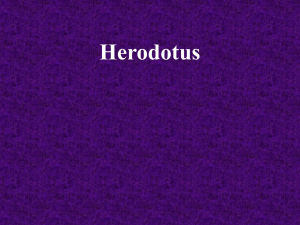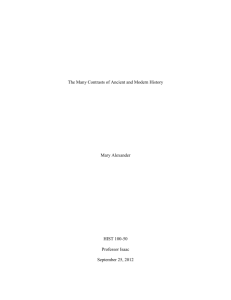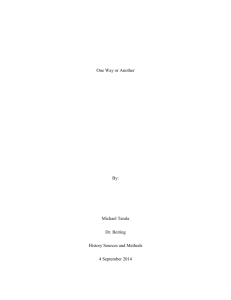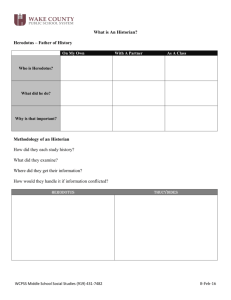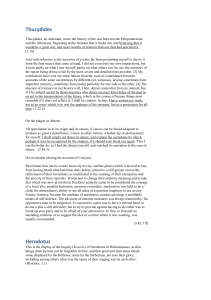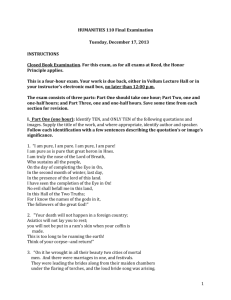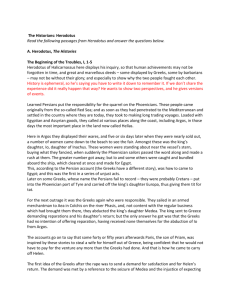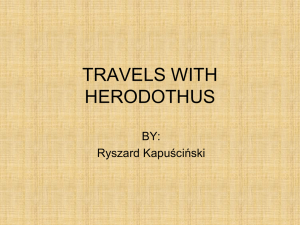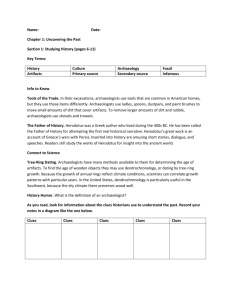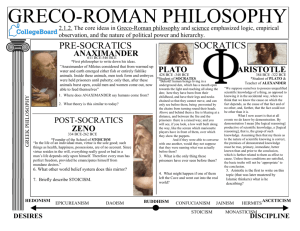section 10
advertisement
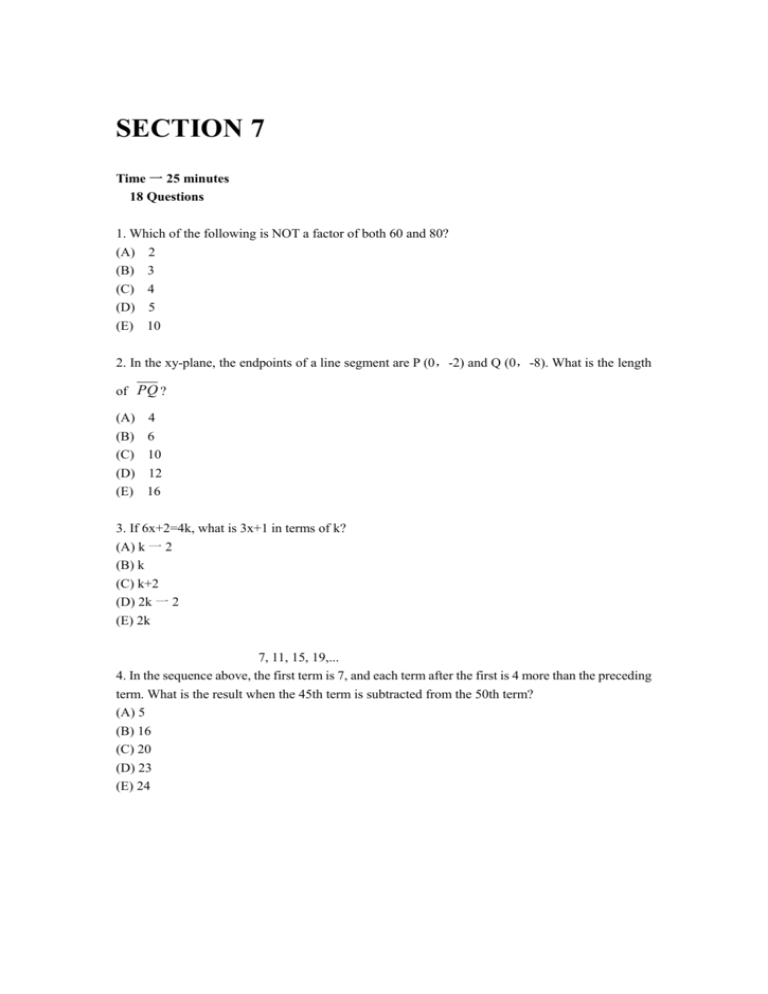
SECTION 7 Time 一 25 minutes 18 Questions 1. Which of the following is NOT a factor of both 60 and 80? (A) 2 (B) 3 (C) 4 (D) 5 (E) 10 2. In the xy-plane, the endpoints of a line segment are P (0,-2) and Q (0,-8). What is the length of PQ ? (A) (B) (C) (D) (E) 4 6 10 12 16 3. If 6x+2=4k, what is 3x+1 in terms of k? (A) k 一 2 (B) k (C) k+2 (D) 2k 一 2 (E) 2k 7, 11, 15, 19,... 4. In the sequence above, the first term is 7, and each term after the first is 4 more than the preceding term. What is the result when the 45th term is subtracted from the 50th term? (A) 5 (B) 16 (C) 20 (D) 23 (E) 24 5. In the figure above, AD=AE=BE and AB=DE. It AE=24 and CD=11, what is the perimeter △ACE? (A) 46 (B) 50 (C) 59 (D) 60 (E) 61 of 6. If the average. (arithmetic mean] of .x, y, and z is〕 ,what is x+z in terms of y ? (A) 2y (B) 3y 2 (C) y y 2 y (E) 3 (D) 7. Esther's mother earned $8 more than 3 times the amount Esther earned during the summer. If Esther's mother earned m dollars, which of the following represents the amount, in dollars, that Esther earned during the summer? (A) (B) (C) (D) (E) 8. The graph of the function/、is shown above. The function g' (not shown) is defined by the equation g(x)=f(x)+4. For which of the following values of x is g(x)=0? (A) 0 (B) 2 (C) 4 (D) 5 (E) 8 9. On the number line above, point R (not shown) is the Midpoint of segment PQ . What is the coordinate of point R? 10. In a parking lot, the number of trucks is half of the number of ears. If there is a total of 24 trucks and cars in the parking lot, how many trucks are there'? 11. In the figure above, the two circles have centers A and B and are tangent at point N. What is the length of segment AQ? 12. A rectangular animal pen is to he made against a wall with 100 feet of fencing. The area, in square feet, of the animal pen is modeled by the function A above, where x is the width, in feet, of the pen. What is the area, in square feet, of a pen that has a width of 7 feet'? 13. In the figure above, point O lies on AE . What is the degree measure of LCOE?(Disregard the degree symbol when gridding your answer.) 14. The circle graph above shows the percents of 20 households that have particular numbers of pets. For example, 15 percent of the households each have 3 pets. What is the total number of pets in the 20 households'? 15. In the above, C is the center of square ABEF. If EF=10 , what is the area of polygon ABCD ? 16. In the system of equations above, x≠0. What is the value of ? 17. A promoter of an event must decide on a single price for all tickets for the event. The incomplete table above indicates some alternative prices and the minimum number of tickets to be sold at those prices to cover the cost of the event. The number of tickets to be sold is inversely proportional to the price per ticket. What is the value of x? 18. if a,b, and c are positive integers and, for all values of x, ax 十 6(x+c)=17x+52, what is one possible values of a? SECTION 8 Time 一 20 minutes 19 Questions 1. Because of its beautiful photographs and clear text, the new book on Pueblo cliff villages will be-----not only for specialists but for------readers as well. (A) accessible ..general (B) uninteresting ..scholarly (C) confusing ..critical (D) unmarketable ..casual (E) available ..trained 2. Unlike most business historians, Smith is neither a defender nor an opponent of the companies she writes about; such objectivity is exceedingly------ in this highly------field. (A) rare ..combative (B) common ..divisive (C) predictable ..complacent (D) surprising .cooperative (E) typical ..cordial 3. A trial transcript is a---一 record of courtroom testimony, useful whenever a witness's exact words must be repeated. (A) verbatim (B) subjective (C) spurious (D) marginal (E) vigorous 4. The many factors affecting a species' abundance seldom act in------;on the contrary, interactions between factors are commonplace. (A) haste (B) principle (C) place (D) isolation (E) miniature 5. Her prose is------in all ways but one: it is often given to a------of descriptive detail that threatens to overwhelm every cogent observation. (A) minimalist ..paucity (B) immutable ..fulsomeness (C) irksome ..felicity (D) tenacious ..vacillation (E) exemplary ..superfluity 6. Derek's------nature worried his friends, who thought such fearlessness would one day lead him into danger. (A) callous (B) intrepid (C) circumspect (D) disingenuous (E) mercurial Questions 7-19 are based on the following passages. These passages discuss the reliability of the ancient Greek historiarn Herodotos (c. 484-425 B.C.E.). Passage 1 Line 5 10 15 20 25 30 35 40 Herodotus himself does not expect us to believe everything we read. For him the word historic meant "research" or "investigation, enquiry,'" and he often emphasizes that what he gives us is provisional information, the best that he has been able in his researches to discover. He sometimes interrupts the ongoing account in his first-person voice as the narrator, precisely to remind us not to treat the ongoing narrative as definitively true. In discussing the thorny issue of whether the: Argives went over to the Persian side in the Persian Wars, he adds: "1 am obliged to record the things I am told, but 1 am certainly not required to believe them 一 this remark may be taken to apply to the whole of my account." In one way this makes Herodotus' Histories a profoundly historical text. Where later narrative historians like Thucydides, Tacitus, Gibbon, or the Durants broke down their informants' reports into data, and from that data constructed their own authoritative version of events, Herodotus takes a different approach. What he claims, at least, to give us is in each case the best version or versions of past events and the distant reaches of the present that he has been able to hear, taken from the most qualified informants he could find. Thus he narrates, for instance, the most credible of the many versions available to him of Cyru’s death. He strings these stories together to form the ongoing narrative of his Histories. Clearly the initial selection of stories, the pacing, the structuring, and much in the literary presentation reveal Herodotus' own interests, values, and gifts as a narrator; he insists, however, that the contents of the stories are not his, but nave peen gathered from others. The phrases "it is said" or "they say" occur hundreds of times in the narrative, as Herodotus reminds us that he owes his stories to others who have told them to him. He names a handful of his informants. Some, especially priests at temple sites, he identifies without naming; several hundred times he cites unnamed speakers by their cities: Spartans, Corinthians, Athenians; and non-Greek interlocutors from farther off as well: Egyptians of course, but also Arabians, Ethiopians, and many others. On his extensive travels Herodotus talked with a wide variety of 45 people;in most instances we can only guess where he spoke to them, what problems he might have had in communicating cross-culturally or through an interpreter, and how accurately he remembered or transcribed what they told him. What he repeatedly emphasizes is that his stories contain real information, but he remains aware, and wants us to be aware too, of the fact that as data they arc only as good as the quality of his sources allows. Passage 2 50 55 60 65 70 75 80 Scholars skeptical of Herodotus emphasize- that as modern readers we must remain aware of the vast gulf that separates our own sense of what it means to preserve the past from those that prevailed in the mid-fifth century B.C.E. Modern students of oral history, drawing on the comparative study of other oral cultures, claim that three generations is the outside limit to be placed on the accurate oral transmission of past events; judged by this standard, much of the information included in the first tour books of the Histories would not be considered historical. In assessing ancient traditional stories, moreover, two particular sources of error must also be kept in mind, apart from the accidental distortions created by the passage of time: first (something Herodotus himself was acutely aware of), stories preserved orally from the past are by definition particular and tendentious in nature 一 the people who remembered and told them have always told them from their own (limited) funds of information, and for their own reasons; second, ancient social memory habitually supplied highly personal motives as explanations for events that modern historians would consider largely the product of impersonal economic or social forces. Our dependence on Herodotus for archaic Greek history lends a particular urgency to a second set of issues involving Herodotus' own credibility as a historian. Some ;scholars Gave scrutinized the text of the Histories and have come to the conclusion nut merely that it is unhistorical, but that it was intended by Herodotus to mislead us by persuading us through its rhetoric to read it as history. Detlev Fehling in particular argues that Herodotus use of source citations is simply ton good Co be true. According to Fehling, sources cited in the Histories always improbably support a partisan version of events put forward by their own city; moreover, Herodotus more than once claims two or more widely removed and thus apparently independent 85 90 sources for obviously fictive "information"; both the systematic tidiness and the harmonious meshing of (invented) information show us that the informants themselves have been invented by the author. According to this view, Herodotus is not at all a historian, or someone with any respect for data, but on the contrary a gifted narrator who has virtually made up the whole of what he recounts. Herodotus: The histories translated by waterfield (1998). Circa 1600w from pp. xxvii-xxxiii. By permission of Oxford University Press. 7. Both passages mention Herodotus' strength as (A) storyteller (B) an interviewer (C) a negotiator (D) a theorist (E) an explorer 8. Both passages indicate that Herodotus believed that some of his sources (A) deliberately attempted to mislead him (B) should not be regarded as totally trustworthy (C) were probably less reliable than those used by other historians (D) contradicted themselves without realizing it (E) pretended to witness events that they could not have seen 9. 1n line 8, "treat" most nearly means (A) regard (B) remedy (C) debate (D) pay for (E) comment on 10. The quote from Herodotus in lines 10-13 primarily serves to (A) demonstrate a consensus (B) supply“:counterexample (C) explain an exception (D) illustrate a claim (E) define a term 11. The reference to Herodotus' account of Cyrus' death (lines 23-25) serves to illustrate (A) Herodotus' excessive faith in his sources (B) Herodotus' affinity for entertaining stories (C) a method Herodotus claimed to employ (D) an advantage Herodotus saw in his approach (E) an account Herodotus seems to have invented 12. Lines 42-46 ("in most ..told him") primarily serve. to (A) emphasize uncertainties about Herodotus' gathering of information (B) justify the skeptical attitude some scholars take toward Herodotus' work (C) explain why Herodotus was dubious about some of his sources' claims (D) advance the idea that Herodotus may have invented some of his information (E) refute the suggestion that Herodotus did not actually interview anyone 13. In line 56, "outside" most nearly means (A) extraneous (B) negligible (C) maximum (D) superficial (E) secluded 14. The conclusion about the Histories proposed in lines 58 一 59 ("much .historical") depends on which of the following assumptions about people in the "other oral cultures" (line 55)? (A) They have more ways to transmit information over time than people did in Herodotus' era. (B) They have higher standards for accurately transmitting oral information than people did in Herodotus' era. (C) They can accurately transmit a greater amount of oral information over time than could people in Herodotus' era. (D) The accuracy with which they transmit oral information over time is less than the accuracy was for people in Herodotus' era. (E) The length of time over which they can accurately transmit oral information is representative of what people could do in Herodotus' era. 15. Lines 72-74 ("Our ...historian") suggest that the "second set of issues" is particularly important because (A) some of Herodotus' claims contradict archaeological evidence (B) Herodotus clearly intended to mislead future historians (C) Herodotus' method is widely used by historians (D) Herodotus has been unfairly maligned (E) historians rely heavily on Herodotus 16. The "scholars" cited in line 75, Passage 2, would most likely describe the view of Herodotus put forward in Passage 1 as (A) deservedly influential (B) excessively sentimental (C) overly credulous (D) unnecessarily pedantic (E) refreshingly candid 17. Both Passage 1. and Detlev Fehling (line 79, Passage 2) address the issue of Herodotus' reliability by analyzing Herodotus' (A) falsification of data (B) sequencing of events (C) use of sources (D) theoretical arguments (E) autobiographical comments 18. Detlev Fehling (line 79, Passage 2) would most likely speculate that the "unnamed speakers" mentioned in line 37, Passage 1, were (A) misunderstood by Herodotus (B) fabricated by Herodotus (C) underused by Herodotus (D) biased in favor of Greece (E) biased in favor of Persia 19. Lines 83 一 88 ("moreover…author")suggest that in an authentic work of history, it is reasonable to expect that (A) trusted sources will occasionally be found tee have misrepresented some facts (B) obviously fictive information will be shared by many sources (C) partisan versions of events will be put forward by most sources (D) independent sources will sometimes disagree with one another (E) empirical data will sometimes conflict with reports from human sources SECTION 9 Time 一 20 minutes 16 Questions 1. If 8x=5y, then 8x 一 5y= (A) 0 (B) 58 (C) 8.5 (D) 5 (E) 8 2. A sponsor of one person walking in a charity walkathon will donate $7.00 plus an additional $0.25 for each mile the person walks. Which of the following functions, d, models the total amount, in dollars, that the sponsor will donate to the charity when the person walks m miles'? (A) d(m)=7.00+rn (B) d(m)=7.00+0.25rn (C) d(m)=7.00m+0.25 (D) d(m)=7.25+rn (E) d(m)=7.25rn 3. In the figure above, point C is on segments AD and BE . What is the value of x? (A) 30 (B) 40 (C) 50 (D) 60 (E) 70 4. The bar graph above shows the eye color of 29 students in a math class. What fraction of the students do not have blue eyes? (A) (B) (C) (D) (E) 4 29 7 29 10 29 15 29 22 29 5. The sum of n and 5 is equal to 2. What number is equal to n minus 4? (A) --7 (B) --3 (C) -1 (D) 3 (E) 7 6. If x<y<0, which of the following is true? (A) x+y<0 (B) x+y=0 (C) x+y>0 (D) xy=0 (E) xy<0 1 1 miles through the woods in 2 hours. She hiked the return trip at the same 2 4 1 average rate but by a different route, taking 2 hours. How many miles did Jinghua hike on the 2 7. Jinghua hiked 4 return trip? (A) 4 3 4 (B) 5 (C) 5 1 2 (D) 6 (E) 6 1 4 8. Some values of the functions f and g are shown in the table above, For which of the values of x in the table does f(x)=g(x)+2x? (A) -5 (B) -1 (C) 0 (D) 2 (E) 3 9. A small-bird habitat at a zoo contains only finches and parakeets. The ratio of the number of parakeets to the number of finches is 5 to 2. One of the birds in the habitat is to be selected at random. What is the probability that the bird selected will be a finch? (A) (B) (C) (D) (E) 2 7 2 5 5 7 7 5 5 2 10. The vertices of a rectangle are consecutively labeled A, B, C, and D in a clockwise direction. Which of the following must be true? (A) AB>BC (B) AB>AC (C) AC>AD (D) BC>AC (E) BC>CD 11. For all numbers x and y, let x possible value of x (A) 0 (B) 1 (C) 2 (D) 3 (E) 4 y be defined by . What is the smallest y? 12. For how many positive two-digit integers is the tens digit less than the ones digit? (A) 36 (B) 38 (C) 40 (D) 42 (E) 50 13. In the xy-coordinate plane above, line f (not shown) contain., the point (0,一 2). Each of theother points on line lies in either quadrant III or quadrant IV. What is the slope of line ? (A) -2 (B) -1 (C) 0 (D) 1 (E) The slope is undefined 14. Pink paint is made by mixing 5 parts white paint with 1 part red paint. If Joseph uses this method for making pink paint and he has 3 gallons of white paint and I gallon of red, what is the maximum amount of pink paint that Joseph can make? 2 gallons 5 1 (B) 3 gallons 2 (A) 3 2 gallons 3 3 (D) 3 gallons 5 (C) 3 (E ) 15. If 3 (A) x 4 gallons , where 5 (B) x and 6 (C) x , what does 7 (D) x equal in terms of x? 8 (E) x 16. In the figure above, △ABC is inscribed in the circle, which has center O. If AB=AO, what is the measure of BCA ? (A) 25° (B) 30° (C) 45° (D) 50° (E) 60° SECTION 10 Time 一 L0 minutes 14 Questions 1. When reading a poem, you should read slowly to have given oneself the opportunity to savor the details of its language, form, and sound. (A) to have given oneself (B) to give yourself (C) for oneself to be given (D) for oneself to have (E) so that you had had 2. The economist estimated that workers in our city spend an average of 40 minutes daily traveling to their jobs and 50 minutes returning home. (A) workers in our city spend (B) a worker in our city who spends (C) they who work in our city spends (D) those who work in our city spending (E) our city's workers having spent 3. Neuroscientists have gained new insights into how the bra 川 works by adopting research methods used to study other elaborate systems, this ran es from computer chips to the stock market. (A) systems, this ranges from computer chips to (B) systems with a range from computer chips and (C) systems ranging from computer chips to (D) systems, it ranges over computer chips and (E) systems, they are ranging from computer chips to 4. Most of the. objects in the museum's ceramics collection are porcelain pieces from Germany, although the collection also includes pieces From Turkey, Korea, and Japanese ceramics are also represented. (A) and Japanese ceramics are also represented (B) as well as Japanese ceramics (C) and from Japan (D) and Japan (E) and also from Japan 5. Most states in the United States had enacted child labor laws by 1920, but not until 1938 when the Fair Labor Standards Act established a national minimum working age. (A) but not until 1938 when (B) but it was not until 193$ that (C) not until 1938 did (D) it was, however, not until 1938 that (E) and not until 193$ when 6. The largest hot desert in the world,the Sahara covers well over three million square miles, and eleven countries are spanned by it. (A) miles, and eleven countries are spanned by it (B) miles and spanning eleven countries (C) miles and spans eleven countries (D) miles, it spans eleven countries (E) miles, with eleven countries spanned by it 7. Adopted in 1997, the Kyoto Protocol is what was the international agreement to reduce the greenhouse gas emissions of industrialized nations over a five-year period. (A) is what was the international agreement (B) was when it was internationally agreed (C) was where the international agreement was (D) being internationally agreed (E) is the international agreement 8. During the 1990s, the number of factory outlet malls greatly increased in the United States, at which brand-name goods are sold at discount paces. (A) During the 1990s, the number of factory outlet malls greatly increased in the United States, at which brand-name goods are sold at discount paces. (B) Factory outlet malls in the United States greatly increased in number during the 1990s, at which brand-name goods are sold at discount prices. (C) Greatly increasing during the 1990s were the number of factory outlet malls in the United States, at which brand-name goods are sold at discount prices (D) The number of factory outlet malls, at which brand-name goods are sold at discount prices, greatly increased in the United States during the 1990s (E) In the United States, the number of factory outlet malls greatly increased during the 1990s, at which brand-name goods are sold at discount prices 9. With an average depth of about 12,000 feet, the extremes of darkness, high pressure, and cold that characterize the deep sea could not be tolerated by shallow-water animals. (A) extremes of darkness, high pressure, and cold that characterize the deep sea (B) extremes of darkness, high pressure, and cold characterizing the deep sea (C) extremes of darkness, high pressure, and cold that are characteristic of the deep sea (D) deep sea is characterized by extremes of darkness, high pressure, and of being so cold that it (E) deep sea is characterized by extremes of darkness, high pressure, and cold that 10. Scientists investigating the effects of exercise compared the performance of active mice with sedentary mice on a memory test and found that the active mice did better. (A) the performance of active mice with sedentary mice on a memory test and found (B) (C) (D) (E) the performance on a memory test of active mice with sedentary mice and it was found the performances of active and sedentary mice on a memory test and found how active and sedentary mice performed on a memory test, their finding was active and sedentary mice on how they performed on a memory test, they found 11. The Dracula orchids, aptly named because their modified leaves resemble flying bats, have central petals that look like small white mushrooms. (A) aptly named because their (B) aptly named because of their (C) aptly named because of having (D) named that because they have (E) named that because of their 12. Hailed as a remarkable technological advance, Hany Farid developed the software that measures the extent to which images in the media have been digitally altered. (A) Hany Farid developed the software that (B) Hany Farid has developed the software that (C) the software developed by Hany Farid (D) the software, Hany Farid developed it, (E) it was the software developed by Hany Farid that 13. As a delegate to the United Nations General Assembly in 1946, Eleanor Roosevelt and Andrey Vyshinskx debated the importance of free speech. (A) Eleanor Roosevelt and Andrey Vyshinsky debated (B) Eleanor Roosevelt and Andrey Vyshinsky debated over (C) Eleanor Roosevelt and Andrey Vyshinsky, they debated (D) Eleanor Roosevelt debated Andrey Vyshinsky over (E) Eleanor Roosevelt, who debated Andrey Vyshinsky over 14. Some scientists believe that the species known as White's tree frog is able to control the amount of water that is evaporated through their skin, enabling them to control their body temperature. (A) their skin, enabling them to control their body temperature (B) their skin, which enables them to control their body temperature (C) its skin, this enables it to control its body temperature (D) its skin and that its body temperature being controlled in this way (E) its skin and thus can control its body temperature
